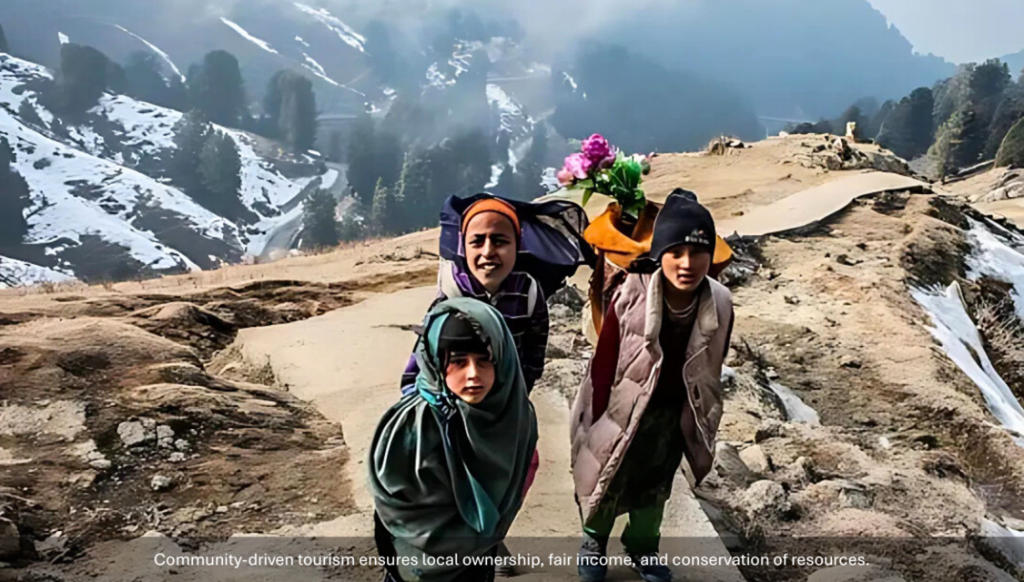Tourism for the Himalayas: Communities Protecting Nature, Culture, and Livelihoods

Eco-tourism has emerged as a global phenomenon where experiential tourism and local hospitality, combined with local cuisine and traditional crafts and music, hold the travel economy together. The growing desire to live and travel sustainably has become the hallmark of young and experienced travellers worldwide. The urge to explore the unexplored and live the unlivable makes community-led eco-tourism sites appealing. Eco-tourism worldwide is all about sharing, learning, and co-creating value that has a lasting ’positive’ impact. It aims not only to reduce carbon and ecological footprints but also to enhance how the travellers contribute to making nature more positive, which is worth the challenge.
Community involvement is the cornerstone of successful eco-tourism in the Himalayas. Unlike traditional tourism, community-led eco-tourism prioritises community empowerment, environmental conservation, and equitable distribution of benefits. Local residents are empowered not just as service providers—guides, homestay hosts, artisans—but also as stakeholders who set the direction for tourism and conservation efforts. Effective participation means communities have real stakes in decision making, receive skill-building and economic opportunities, and take responsibility for stewardship of natural resources. This engagement leads to developmental activities like better sanitation facilities and improved access to water resources, which benefit the local population. They then actively plan, manage, and benefit from tourism initiatives centred on their natural and cultural heritage, as can be seen in the Hindu-Kush region and globally.
Social, Economic, and Environmental Impacts
Ecotourism, well accepted, is grounded in the concept of long-term socio-environmental sustainability, with minimal ecological footprint. More recently, emphasis has been laid on responsible travel to natural areas, with purposes such as acquiring knowledge, co-creating local solutions, learning about the local culture, and admiring natural environments. This contributes positively to preserving ecosystems and the local economy’s growth and development, and also strengthens the local community’s social and cultural traditions and knowledge. It is widely accepted that the fundamental principles of ecotourism include being nature-based, emphasising preservation and conservation, providing education, promoting sustainability, ensuring a fair distribution of benefits, and upholding ethics, responsibility, and awareness.
Eco-tourism with community participation offers threefold benefits:
- Economic gains: Job creation, entrepreneurial ventures, and supplementary income for farming families.
- Social empowerment: Skills training, women’s involvement, educational connections, and retention of youth in mountain villages.
- Environmental stewardship: Conservation of fragile habitats, reduced ecological footprint, and adoption of traditional knowledge for sustainable practices.
These initiatives address traditional challenges such as poverty, gender disparities, and environmental degradation. Revenue generated from tourism is often channelled towards conservation, education, and local infrastructure, allowing communities to thrive while attracting responsible tourists who seek meaningful, low-impact experiences.
What Works and What Does Not
Studies show that successful long-term implementation of community-based ecotourism requires significant community involvement. As eco-tourism initiatives are typically planned in sensitive areas, they can only be sustained when local communities are considered, and where environmental protection and ecotourism benefits increase, as the need to improve the quality of life and conserve resources are priorities. There are a number of successful case studies that emphasise the need for community participation in tourism planning as a pathway to sustainable tourism and poverty alleviation.
It is worth highlighting that low community participation produces low levels of awareness and engagement in projects. And eco-tourism provides avenues for alternate and diverse development mechanisms to achieve conservation and support local livelihoods. Hence, community-led eco-tourism has the potential to contribute to the social and economic sustainability of the local people by providing a new source of income, product creation, and employment.
The Indian Himalayan Region’s eco-tourism journey offers compelling evidence that community participation is the bedrock of sustainable progress. By giving local people control, building their skills, and celebrating their culture, eco-tourism delivers profound socio-economic and ecological rewards.
In this edition of the newsletter, we will explore the many layers of community-led tourism in the Himalayas. In the lead article, Rahul Bhushan, founder of NORTH, reflects on how ecotourism in Himachal Pradesh can regenerate culture, livelihoods, and ecosystems. The Ladakh Homestay Policy, 2023, by Aishwarya Kulkarni talks about policy recommendations for making homestays models of eco-hospitality. From the ground, we share stories of Takmachik’s Apricot Blossom Festival in Ladakh and highlight the community-driven homestay practices in the quaint village of Markha. These narratives capture the everyday realities, challenges, and hopes of mountain communities. Together, these perspectives remind us that the future of tourism in the Himalayas lies in the hands of its people and their enduring connection to land and their traditions.
The views expressed in the article are those of the authors and not necessarily those of Development Alternatives.
This blog first appeared as an editorial in Development Alternatives Newsletter September, 2025 Communities Shaping Sustainable Tourism in the Himalayas






Leave a Reply